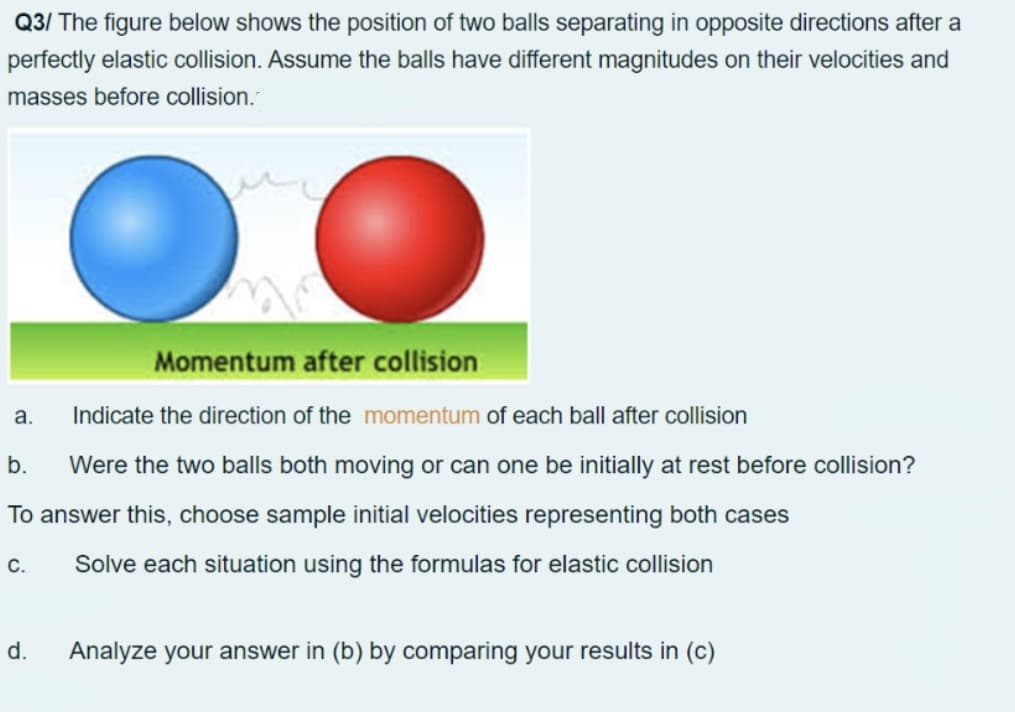Q3/ The figure below shows the position of two balls separating in opposite directions after a perfectly elastic collision. Assume the balls have different magnitudes on their velocities and masses before collision. Momentum after collision a. Indicate the direction of the momentum of each ball after collision b. Were the two balls both moving or can one be initially at rest before collision? To answer this, choose sample initial velocities representing both cases C. Solve each situation using the formulas for elastic collision d. Analyze your answer in (b) by comparing your results in (c)
Q3/ The figure below shows the position of two balls separating in opposite directions after a perfectly elastic collision. Assume the balls have different magnitudes on their velocities and masses before collision. Momentum after collision a. Indicate the direction of the momentum of each ball after collision b. Were the two balls both moving or can one be initially at rest before collision? To answer this, choose sample initial velocities representing both cases C. Solve each situation using the formulas for elastic collision d. Analyze your answer in (b) by comparing your results in (c)
College Physics
11th Edition
ISBN:9781305952300
Author:Raymond A. Serway, Chris Vuille
Publisher:Raymond A. Serway, Chris Vuille
Chapter6: Momentum, Impulse, And Collisions
Section: Chapter Questions
Problem 84AP: A wooden block of mass M rests on a table over a large hole as in Figure P6.84. A bullet of mass m...
Related questions
Question

Transcribed Image Text:Q3/ The figure below shows the position of two balls separating in opposite directions after a
perfectly elastic collision. Assume the balls have different magnitudes on their velocities and
masses before collision.
Momentum after collision
a.
Indicate the direction of the momentum of each ball after collision
b.
Were the two balls both moving or can one be initially at rest before collision?
To answer this, choose sample initial velocities representing both cases
C.
Solve each situation using the formulas for elastic collision
d.
Analyze your answer in (b) by comparing your results in (c)
Expert Solution
This question has been solved!
Explore an expertly crafted, step-by-step solution for a thorough understanding of key concepts.
This is a popular solution!
Trending now
This is a popular solution!
Step by step
Solved in 5 steps with 5 images

Knowledge Booster
Learn more about
Need a deep-dive on the concept behind this application? Look no further. Learn more about this topic, physics and related others by exploring similar questions and additional content below.Recommended textbooks for you

College Physics
Physics
ISBN:
9781305952300
Author:
Raymond A. Serway, Chris Vuille
Publisher:
Cengage Learning

Physics for Scientists and Engineers with Modern …
Physics
ISBN:
9781337553292
Author:
Raymond A. Serway, John W. Jewett
Publisher:
Cengage Learning

Physics for Scientists and Engineers
Physics
ISBN:
9781337553278
Author:
Raymond A. Serway, John W. Jewett
Publisher:
Cengage Learning

College Physics
Physics
ISBN:
9781305952300
Author:
Raymond A. Serway, Chris Vuille
Publisher:
Cengage Learning

Physics for Scientists and Engineers with Modern …
Physics
ISBN:
9781337553292
Author:
Raymond A. Serway, John W. Jewett
Publisher:
Cengage Learning

Physics for Scientists and Engineers
Physics
ISBN:
9781337553278
Author:
Raymond A. Serway, John W. Jewett
Publisher:
Cengage Learning

College Physics
Physics
ISBN:
9781285737027
Author:
Raymond A. Serway, Chris Vuille
Publisher:
Cengage Learning

Principles of Physics: A Calculus-Based Text
Physics
ISBN:
9781133104261
Author:
Raymond A. Serway, John W. Jewett
Publisher:
Cengage Learning

Glencoe Physics: Principles and Problems, Student…
Physics
ISBN:
9780078807213
Author:
Paul W. Zitzewitz
Publisher:
Glencoe/McGraw-Hill